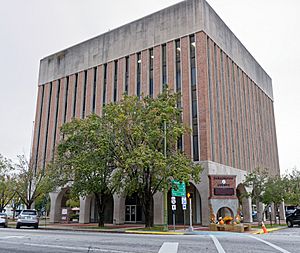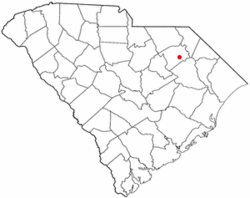Darlington, South Carolina facts for kids
Quick facts for kids
Darlington, South Carolina
|
||
|---|---|---|

Darlington County Courthouse
|
||
|
||

Location of Darlington, South Carolina
|
||
| Country | ||
| State | ||
| County | Darlington | |
| Founded | 1835 | |
| Government | ||
| • Type | City Manager-Council | |
| Area | ||
| • Total | 4.71 sq mi (12.20 km2) | |
| • Land | 4.71 sq mi (12.20 km2) | |
| • Water | 0.00 sq mi (0.00 km2) | |
| Elevation | 148 ft (45 m) | |
| Population
(2020)
|
||
| • Total | 6,149 | |
| • Density | 1,304.97/sq mi (503.85/km2) | |
| Time zone | UTC−5 (Eastern (EST)) | |
| • Summer (DST) | UTC−4 (EDT) | |
| ZIP codes |
29532, 29540
|
|
| Area code(s) | 843/854 | |
| FIPS code | 45-18565 | |
| GNIS feature ID | 1247486 | |
Darlington is a city in Darlington County, South Carolina, United States. It is the main city, or county seat, of Darlington County. In 2020, about 6,149 people lived there. It is part of the larger Florence, South Carolina metropolitan area.
Darlington is famous for its special Darlington Oak trees and the pretty Spanish moss that hangs from them. It is also home to the well-known Darlington Raceway. This track hosts big NASCAR races every year, like the Southern 500 and a 400-mile spring race. Darlington is also an important place for growing tobacco.
The city is located about 10 miles (16 km) northwest of Florence and 76 miles (122 km) northeast of Columbia, the state capital.
Contents
History of Darlington
How Darlington Began
People started settling in this area in the mid-1700s. Farmers from Wales, Scotland, Ireland, and England came here. They mainly grew cotton.
A large area of land was set aside for Welsh Baptists from Delaware in 1736 and 1737. This area was called the Welsh Tract. It was on both sides of the Pee Dee River. The first settlers built the Welsh Neck Baptist Church. Later, in the 1760s and 1770s, other groups arrived. These included families with French, Scottish-Irish, and English backgrounds. They settled near other rivers and creeks.
For about 30 years, there was no local government here. People had to travel all the way to Charles Town to handle legal matters. In 1769, a new judicial district called Cheraw District was created. A courthouse and jail were built and ready by 1772.
Becoming a County
After the American Revolutionary War, in 1785, Cheraw District was split into three counties: Marlborough, Chesterfield, and Darlington. No one is quite sure why the county was named "Darlington." A new main town for the county, called Darlington Court House, was set up in the middle of the county.
Later, in 1888, parts of Darlington County were used to create Florence County. Darlington County also lost some land in 1902 when Lee County was formed.
The Public Square and Courthouse Story
The story goes that the public square and courthouse are in their current spot because of an argument between two men, Colonel Lamuel Benton and Captain Elias Dubose. They couldn't agree if the courthouse should be in Mechanicsville or Cuffey Town. So, they decided to start riding their horses from their towns until they met. The place where they met became the site of the Darlington public square and courthouse.
The first courthouse burned down in 1806. Some people thought an old woman set the fire to destroy papers for her court case. Between 1824 and 1825, a new courthouse was built using bricks. This was done to help stop fires from spreading.
Historic Places to See
Many places in Darlington are listed on the National Register of Historic Places. This means they are important historical sites. Some of these include:
- Cashua Street-Spring Street Historic District
- Julius A. Dargan House
- Darlington Downtown Historic District
- Darlington Industrial Historic District
- Darlington Memorial Cemetery
- Dove Dale
- First Baptist Church
- Nelson Hudson House
- Manne Building
- Clarence McCall House
- Charles S. McCullough House
- Oaklyn Plantation
- St. John's Historic District
- South Carolina Western Railway Station
- West Broad Street Historic District
- Wilds-Edwards House
- Mrs. B.F. Williamson House
Geography of Darlington
Darlington is in the southeast part of Darlington County. Major roads like U.S. Routes 52 and 401 go around the city. US 52 goes southeast to Florence, and US 401 goes southwest to Sumter. Together, they go north to Society Hill. South Carolina Highway 34 goes through the middle of Darlington.
The famous Darlington Raceway is just outside the city, about 2 miles (3 km) west of the city center.
The city of Darlington covers a total area of about 4.71 square miles (12.2 square kilometers), and all of it is land.
Climate and Weather
Darlington has a humid subtropical climate. This means summers are hot and humid, often with thunderstorms. The humidity can cause delays for the NASCAR races held in late summer, which is why the Southern 500 race is now held at night.
Winters are usually mild, but sometimes it gets cold. Darlington gets a good amount of rain. Snowfall is rare because of the mild temperatures, but sometimes a small amount of snow can fall.
The hottest temperature ever recorded in Darlington was 109 °F (43 °C) on September 4, 1925. The coldest temperature was -4 °F (-20 °C) on January 21, 1985.
People of Darlington
| Historical population | |||
|---|---|---|---|
| Census | Pop. | %± | |
| 1880 | 940 | — | |
| 1890 | 2,389 | 154.1% | |
| 1900 | 3,028 | 26.7% | |
| 1910 | 3,789 | 25.1% | |
| 1920 | 4,669 | 23.2% | |
| 1930 | 5,556 | 19.0% | |
| 1940 | 6,236 | 12.2% | |
| 1950 | 6,619 | 6.1% | |
| 1960 | 6,710 | 1.4% | |
| 1970 | 6,990 | 4.2% | |
| 1980 | 7,989 | 14.3% | |
| 1990 | 7,311 | −8.5% | |
| 2000 | 6,720 | −8.1% | |
| 2010 | 6,289 | −6.4% | |
| 2020 | 6,149 | −2.2% | |
| U.S. Decennial Census | |||
According to the 2020 United States Census, there were 6,149 people living in Darlington. There were 2,692 households and 1,514 families.
In 2010, the city's population was 6,289. About 60.4% of the people were Black, and 37.7% were White. A small number of people were Native American, Asian, or from other backgrounds. About 0.7% of the people were Hispanic or Latino.
Education in Darlington
In 1818, Darlington grew enough to build its first school, called The Darlington Academy. In 1860, its name changed to St. John's Academy. This building was used for school and for raising money. St. John's Academy later became St. John's High School.
In 1977, a new school building was built, and it was renamed Darlington High School. This happened when it joined with Mayo High School in 1995.
In September 2006, new school buildings were finished, including The Darlington County Institute of Technology, Darlington Middle School, and Hartsville Middle School.
After schools in South Carolina became integrated in 1996, Mayo High School became a special school called the Mayo High School for Math, Science, and Technology.
Today, the Darlington County School District manages all the schools in the county. Darlington also has a public library, which is part of the Darlington County Library System.
Famous People from Darlington
Many notable people have come from Darlington, including:
- David Beasley, a former Governor of South Carolina and head of the World Food Programme.
- Harry Byrd, a Major League Baseball pitcher who was Rookie of the Year in 1952.
- James Lide Coker, a businessman who founded Coker College.
- Dorsey Dixon, a musician and songwriter.
- William G. Farrow, who took part in the famous Doolittle Raid during World War II.
- Tommy Gainey, a professional golfer on the PGA Tour.
- Raymond A. Harris, a former leader of the South Carolina Republican Party.
- Gloria Hines, the first African-American woman to be elected mayor of Darlington.
- Orlando Hudson, a Major League Baseball player.
- Buddy Johnson, a jazz musician.
- Ella Johnson, a singer.
- Evander M. Law, a general during the American Civil War.
- David Rogerson Williams, a governor and scientist who brought mules to Southern farming.
- Hyman Witcover, an architect.
See also
 In Spanish: Darlington (Carolina del Sur) para niños
In Spanish: Darlington (Carolina del Sur) para niños

